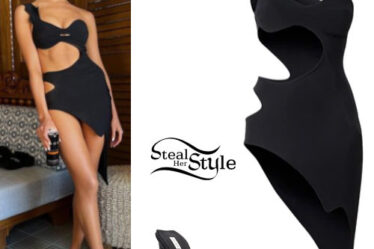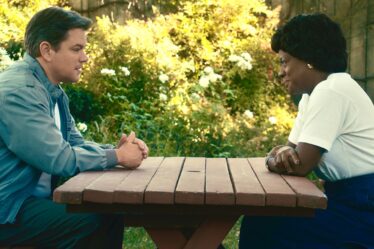
NEW YORK — The lion’s share of runway collections presented in the second half of New York Fashion Week were less about attaching garments to cultural touchstones and more about making interesting, practical clothes to wear every day. (Not everyone gave up on showmanship; more on Thom Browne later …)
The good news is that “normal” clothes don’t mean boring — and their re-emergence might, in fact, be one of the best things to happen in New York in seasons. Whimsical inspirations can be a crutch, giving mediocre clothes worthiness by association. This season, he garments mostly held their own.
Normalcy is at its best in the hands of Luar’s Raul Lopez. Having won the CFDA Award for Accessories Designer of the Year for his popular Ana bags, he graduated to the closing spot of NYFW. The collection he presented in Greenpoint, Brooklyn was something of a sequel to spring 2023′s corporate auntie-core. Titled “Calle Pero Elegante” it was dedicated to the powerful women he admired growing up — “gangstresses” he called them. “My mom always says the man is the head of the house, but the woman is the neck and she moves them wherever she wants,” he said at a preview, where he spoke about creating heritage items that would stand the test of time.
So I’ll let you in on a little secret: the best Luar-ism is that Lopez routinely takes photos of people on the street he finds fabulous — everyone from tourists in Uggs to New York natives in Hermès scarves. His ability to distill and redefine reality into capital-F fashion is so acute, it results in garments uncannily like something you know but shockingly different. Take an iridescent cocoon pinstripe jumpsuit worn with a belt as a bra that forces the model to carry her hands primped over her waistband. Or a brown tracksuit painted with a jaunty feathered hat. Or a double breasted gown with exaggerated shoulders, made of eight shoulder pads layered atop each other. Bizarrely correct, capturing the mood of a suspicious, earnest power that is at the root of femininity. Here’s the other secret: Lopez is the rare designer who sees womenswear as the aspirational standard, cutting his menswear pieces to look more like womenswear ones — not the other way around. That’s his boldest move in American fashion, where a boxy men’s suit still reigns supreme, and why he merits that closing spot of NYFW.
Days earlier in Greenpoint, Elena Velez presented her autumn 2023 collection in a strobe-lit warehouse. When the room suddenly went pitch black, a guest shrieked in fear. That’s precisely the mood Velez is trying to cultivate with her take on femininity: intense, unrelenting and scary. Eartheater — the musician born Trinity Vigorsky — opened an unspooling corset dress complemented by a jilted zombie-like walk.
The haunting continued through “placental” rubber dresses and a model grasping Velez’s recent CFDA Emerging Designer of the Year statuette like a crowbar to “seem like she just bludgeoned her husband with it” the designer half-joked backstage. Some of Velez’s garments are so crude they look like they were dredged up from the depths of Lake Michigan. That’s also the point. Her mother is a ship captain on the Great Lakes, and Velez is determined to showcase the honour and pride of Midwestern making. Her “radically plain” — her words — clothes can seem overly provocative at times, but her devotion to celebrating craft and womanhood make up for it.
No two women could seem farther apart in taste than Velez and Tory Burch, whose collections usually have a measured propriety and pragmatism to them. But backstage Burch was greeting guests with a safety pin stuck through her ear. Since appointing her husband and former LVMH fashion group boss Pierre Yves Roussel as CEO in 2019, Burch has loosened up her runway shows, freeing her women from the total look and designing instead singular pieces for them to cherish. On Monday evening, Burch sent out a strong effort of “imperfect” clothes styled to look much like the way Burch’s customer dresses: gray sweaters with the sleeves pre-scrunched, navy peacoats with knee-high boots, curve-hugging off the shoulder dresses with fishnet tights.
There were a few surprises up Burch’s sleeve: a chartreuse back-to-front satin dress fastened with a safety pin, a black backless dress with a cascade of emerald beads, and lingerie bodices with a quirky bulkiness to them all read as appropriately sexy. In these three styles of going out clothes Burch proved her appeal: she can make a dress for a woman who is 62 or 42 or 24 — not many other American brands can do that and carry off a runway show.
Gabriela Hearst has a wide range of fans, too, as her front row proved, from Lauren Hutton to Diplo, Robert Kraft to Rebecca Hall. While she did cite the artist, designer and architect Eileen Gray as her muse this season, offering a SparkNotes version of Gray’s life backstage, Hearst never strays far from her message of neutral-toned, luxuriously demure clothing. The closest parallels to Gray’s oeuvre are metal-hipped dresses that will be custom-molded for clients inspired by the artist’s use of chrome in furniture and architecture.
Elsewhere, bonded leather maxiskirts, geometric leather trenches, and pleated skirts with diamond-cut outs at the knees were the most interesting ideas on the runway, adding new movement and dynamism to Hearst’s collection. Backstage she said something that struck me: “I’m in the service of destiny.” As a person, Hearst is incredibly interesting in her mannerisms, her beliefs and her spiritualism. I think her brand, or at least its public-facing efforts, could use more of her own personal magic.
Coach’s Stuart Vevers was front row at Gabriela Hearst’s show having presented his pared-back and direct vision for Coach the day before. “It was a very deliberate move away from the cinematic influences of recent seasons that can be quite escapist to something that, I was hoping, would feel more real,” he said of his slashed denim skirts, micro leather shorts, and sheer macaron-coloured slips. Mission accomplished. Gold metallic coats and giant shearlings added to the verve and lent a maturity to his catwalk. No longer did the Coach models look like teens, they looked like 20-somethings or 30-somethings ready to stomp over their Gen-X bosses. Much like his friend Gabi, Vevers doesn’t often stray far from his core vision, but in leaving the whimsy and cutesiness of previous Coach seasons in the past, he’ll reach a wider, more mature audience.
The best thing about a Michael Kors show is the Michael Kors of it all. While other designers are questioning and iterating, Kors is unflinching in what he has to offer. It’s always swishy, it’s always cashmere, it’s definitely got a sequin, and it’s undoubtedly in homage to the glamazons of Kors’ past. This season he looked to the ‘70s — arguably the Korsiest decade — for Lena Horne bell sleeves, low-slung Gloria Steinem belts and Studio 54 jumpsuits with flared hems. The entire collection was in neutrals, styled monochrome so that leopard coats were worn with leopard boots and a jersey chiffon dress with cashmere inset belt (kind of genius in how luxurious and impractical it is) is worn with matching boots and bag. In another season where Kors’ peers were channeling more fantastical ideas this straightforward simplicity might have felt out of place, but amongst the wearable clothes of NYFW his collection felt in step.
Brandon Maxwell took a page from the Kors playbook with his parade of twisted basics. Tuxedo shorts and strappy crop tops were some of his less successful ideas, countered by lovely tank dresses and rich-looking knit pieces with flared peplums or skirts. Khaite, too, struggled to make the ordinary extraordinary, leaning too heavily on gimmicks like shearling trousers and bulky coats. It was severe; maybe a little cold.
Willy Chavarria cemented his place as New York’s most stealthy influential designer with an eveningwear show at the Cooper Hewitt Museum. Working in mostly black and white, Chavarria layered bow neck blouses under workwear jackets and created tuxedo-meets-parka gowns worn by models of all genders. He has a quiet fury to his work, having fought hard for a place in the American fashion pantheon, and his show soundtrack of a live violin quartet and singer only underlined the intense, pointed precision of his vision. He doesn’t need to scream anymore to get attention to his half-pleated trousers or slightly cocooned leather jackets. After seasons of staking a claim, he is accepting his worthiness with a relaxed, polished, and sophisticated collection that whispers.
Chavarria’s rise from fashion outsider to insider bodes well for New York’s new guard — and there are many from Commission to Saint Sintra to SC103 to the just-graduated-from-SCAD Kate Barton, all who offer singular takes on the future of fashion. And all who held presentations or appointments because of NYFW’s crowded schedule. One who made it to the catwalk was Palomo Spain’s Alejandro Gómez Palomo, decamping to New York this season to show his bow-trim briefs and pastel puffer dresses for men. The designer’s past collections hewed so closely to costume it was hard to imagine him making ready-to-wear, but this collection proved he’s got the chops to turn tweed suiting into kinky little minis and jeans into sparkly and special trousers. “We want to be a brand that is actually a reality,” he said.
LaQuan Smith’s reality has to do with dressing up to go out. He knows his sexy streak has appeal and doesn’t futz with the formula. The most exciting development there was Smith walking his own runway show. On one hand it seemed a stroke of bravura, on the other, you have to question why, when white male European designers who also make sexy skimps of clothing and put themselves in their lookbooks are getting big creative director jobs and Smith is not. He’s a far better tailor than some of those guys in England and France and he’s got the plunging waists and bumsters to prove it.
Joseph Altuzarra is another strong New York designer who has never scored a creative director gig at a European house. It’s probably a good thing; he speaks his own language of free spirited luxury too well. At a preview before his show, he spoke about moods, feelings, and reading the tea leaves of fashion’s future. The woo-woo spirit led him to create rorschach-printed parkas, fauna-printed dresses and incredible evening puffers in jewel box colors. Leather pieces are self-wrapping, so the wearer can style as she pleases and shibori peplum tops are intricately hand-pleated and stitched. The Altuzarra version of reality doesn’t exactly have mass appeal, but he knows his niche of posh, smartly elegant women well.
Delay breeds desire, right? So as we waited for Erykah Badu to arrive at Thom Browne, the audience started to speculate about what story Browne was going to tell. We had a downed airplane, a solar system, and a ticking clock as hints, but a narration by Browne’s friend Sarah Jane when the show finally started confirmed it: The Little Prince. The book’s tender and ultimately brokenhearted narrative was a vehicle for Browne to flex his prowess as a technician. Baobabs were made into intarsia translucent column dresses, asteroids wore de- and re-constructed tailoring in hulking silhouettes with roped shoulders and ribbon tweeds, and Sara Grace Wallerstedt as the fox wore a draped jacquard and gold bullion embroidered dress and fox-shaped purse, one-upped only by Debra Shaw as the pilot in a curved space suit with hand-pulled green fringes to imply planet earth.
The Little Prince is the perfect book for a designer so high in the sky and pure in the heart like Browne. “The story says that children see more than adults do,” Browne said backstage, concluding, “I like to see things that way.” Naiveté can do wonders for the overstuffed fashion world. A reminder that Browne didn’t study design in school, he wasn’t trained as a tailor, he didn’t even start making clothes until his late 30s. And yet he spins the best yarn and makes the most popular gray wool suits of New York Fashion Week.



